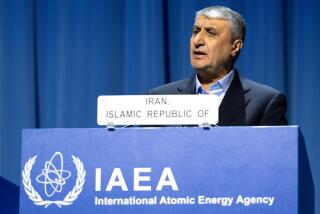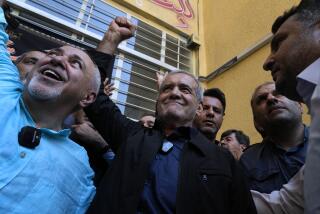Tehran’s ‘Populist’ Leader Clashes With the People
- Share via
Mahmoud Ahmadinejad, the winner of Iran’s version of a presidential election, has been called conservative, and even ultraconservative. He is neither but rather a fundamentalist, a xenophobe and a populist who declares that in recent years Iran has become too sexually tolerant at home and too moderate abroad, while a narrow elite enriched itself.
The key promise of his election campaign, in true populist fashion, was to increase wages and pensions while reducing prices. But his candidacy was originally propelled by the country’s extreme fundamentalists, who want to see all women shrouded in black and no more mixing of the sexes in elevators, at soccer games or even in parks. This sexually obsessed puritanism is combined with xenophobia -- Ahmadinejad was one of the founders of the student group that seized the U.S. Embassy in Tehran. He mixed moderate and radical phrases in his first news conference after his victory, but it was the first one in years in which no English translation was provided.
It is in character that Ahmadinejad has coupled his promise to distribute oil revenue more widely with the warning that Iran’s recent oil and gas deals with foreign companies would be reviewed for irregularities. Iran’s presidents do not control foreign policy, but Ahmadinejad’s specifically Persian xenophobia may be very important all the same, because Azeris, Kurds, Arabs and other minorities account for almost half the country’s population. As it is, Arabs and Kurds are restive, with frequent episodes of violence, and are unlikely to accept more Persian and religious oppression quietly.
Ahmadinejad’s 17 million votes, as reported by the Interior Ministry, amount to 36% of the electorate, but it is exceedingly unlikely that his extreme views reflect the opinions of that many Iranians. He was running against Hashemi Rafsanjani, widely hated as the richest of the corrupt priests who control much of Iran’s economy. Many of Rafsanjani’s 10 million votes came from desperate moderates who had nobody else to vote for.
Iran’s extremists, led by the all-powerful Ayatollah Ali Khamenei, have now completed their conquest of every part of the government. They control the judiciary, and last year they used the unelected Guardian Council to exclude almost all moderate candidates from the general election for the parliament.
The presidency has been held by the former hope of the moderates, Mohammad Khatami, whose pleasant manner and soft language made for good public relations outside the country, but who had no control over the army, police, foreign policy, nuclear policy or much of the budget. Khatami tried to legitimize the very tentative, very modest liberalization that Ahmadinejad finds intolerably permissive. Now Khatami too is gone.
But the extremists do not control Iran’s multiethnic and exceedingly young society. When clerics venture into central Tehran, they change into street clothes if they can because they are often insulted -- and so few taxis pick them up. Clerical oppression has made many Iranians post-Islamic. Ahmadinejad is on a collision course with a large majority of Iranians, and is unlikely to avoid a crash.
More to Read
Sign up for Essential California
The most important California stories and recommendations in your inbox every morning.
You may occasionally receive promotional content from the Los Angeles Times.










